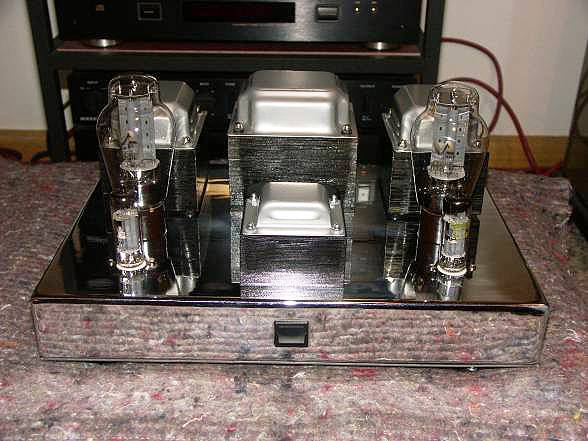
| [ Audiophon 300B Single Ended power amp ] |
© Ernest Ruiz. 2006

After some months without any audition, now I'm here to introduce to you the Audiophon 300B Single Ended power amp. I believe that this is a great way to start again these series of articles introducing to all of you this brand and its equipment. Those who are visitors of this web site maybe remember the article I wrote at the end of october 2006 about Audiophon and the man behind this brand, Rafael Molina. I resumed this visit in the article Audiophon: Craftmanship in sound where you can find all the details of Mr. Molina's work, his history, the equipment he builds and sells, etc. The article you are going to read started with this visit. As always with my auditions this one has been very interesting. Let's start with it.
The Audiophon 300B single ended it's a power amp designed to work with the classic 300B power tube. The original 300B was first manufactured by Western Electric in 1938. It is a low power triode designed for audio uses that delivers a maximun of 9 watts in class A. Probably the 300B is the best known power tube among audiophiles and the one with the longest life, because it was made by Western Electric without interruptions from 1938 to 1988. After some years without manufacturing this tube, Western Electric started again to produce it in the mid 90s after seeing the high demand and prices of these tubes in the second hand market. Today they are still manufacturing the 300B and other audio tubes. Some audiophiles believe that this tube represents the essence of all tube amplification. Almost all of tube lovers look at the 300B with respect and when it is used in equipment like that we understand why.
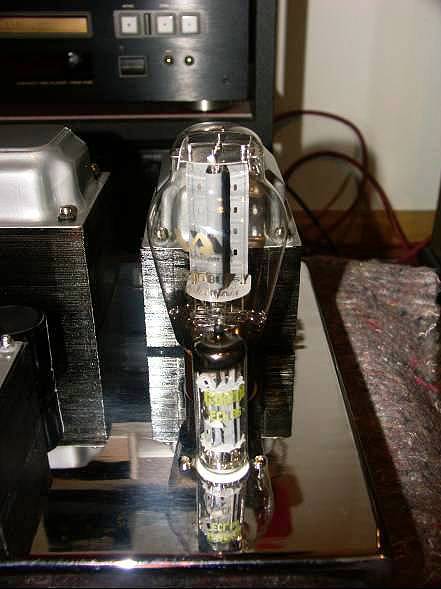
The Audiophon 300B works in pure class A using one 300B power tube per channel and one ECL86 pentode/triode tube in the preamp section configured in triode/triode mode. The unit used in this audition uses Valve Art 300B tubes and ECL86 RFT NOS and delivers 9 watts per channel. As you can see I'm talking specifically about the unit tested here because you should realize that this is a hand made product that can be tailored to the users needs and so its specs can vary greatly if someboby asks for other types of 300B tubes, different output transformers or any other of the alternatives that Mr. Molina gives to his customers.
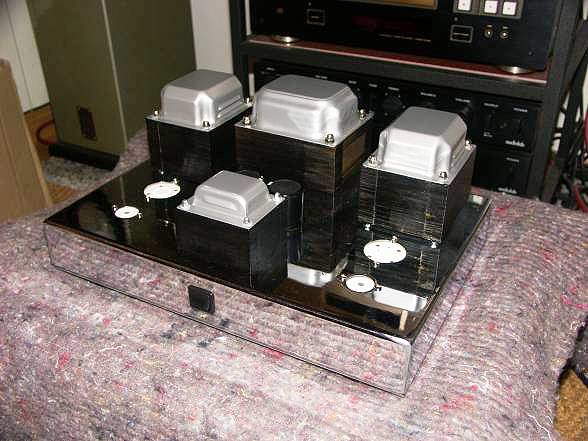

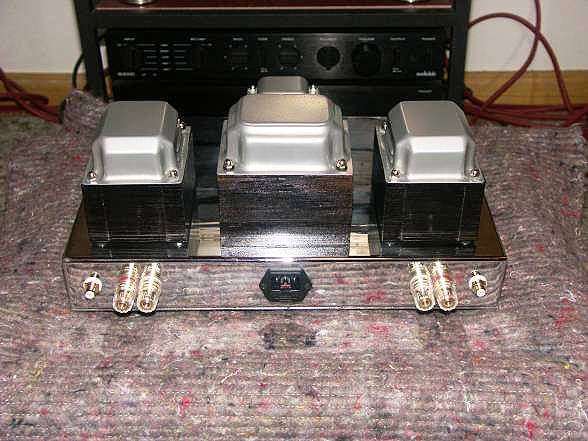
Once unpacked we can look at some building aspects of the Audiophon. This power amp, as usual with many hand made designs is quite simple but nothing is missed. The Audiophon uses a chromed chassis very well finished. The front panel has the on/off switch and a small led that shows us if the amp is connected or not. In the back panel we find gold platted RCA connectors of excellent quality, the speaker binding posts also gold platted that accepts bare wire of bananas and the power plug that allows the use of different power cables if the user wants to do it.
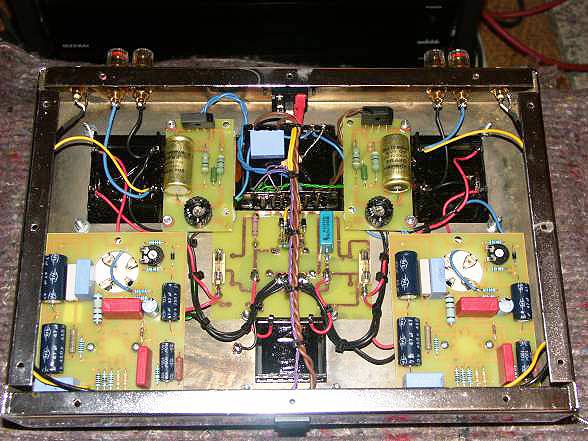

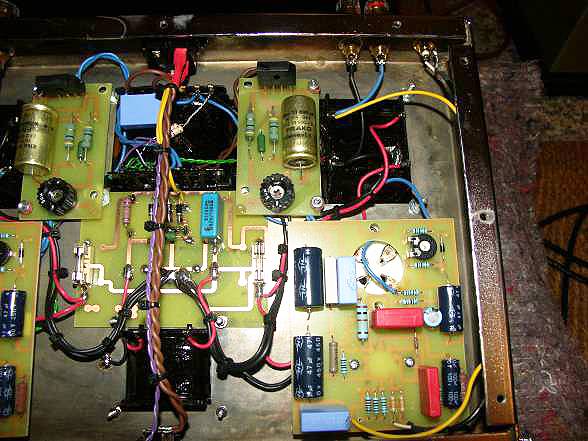
If we take a look to the interior of the amp we can see that everything has been considered to the minimun detail. It is one of those designs that make us smile. As you can see all the components are mounted on printed circuit boards that Mr. Molina builds by himself. All the components used are of very good quality and it is clear that the layout of all of them have been studied. The circuit is almost dual mono, neat and simple, what we always want to see inside an amp like this.
In addition to the outside and inside building aspects there's one point that must we considered when we talk about this amp. I'm talking about the output transformers. They are made in-house by Mr. Molina that has all the knowledge and experience to do this complex process succesfully. Some people consider the output transformes the most important part of a tube amplifier and the ones used in all the Audiophon range are very special.
Before talking about the audition, there's something I want to comment that I consider very important for future users of this or similar amps. I believe that this system is intended for a different kind of audiophiles. If all the amplifiers that I have listened until know can be considered as the "first amplifier" that everybody can buy, this one is in a different league, where serious things begin. Because working with this kind of amps, specially in those areas referred to its low power, is something that must be taken seriously. If with more powerful designs, such as push-pull systems based on tubes like the EL34 or 6L6, we can work with modern speakers with medium sensitivities, when we use low or very low powered triode amps (a 45 delivers only 2.5 watts!) we must know what we're doing and what are the specifications and needs of these amps. I don't mean that a low powered amp is a problematic one, but its specifications require a closer look to details that can be avoided with other designs. Keep this in mind if you are considering buying an amp like this. And know let's talk about how the Audiophon 300B sounds.
The system used in the audition of the Audiophon 300B has been an Audiolab 8000C preamp, a TEAC VRDS10SE CD player, an Audiolab 8000DAX converter, a pair of Monitor Audio Studio 20 SEC speakers, OFC standard speaker cable and Cardas 300B Microtwin for interconnections. The first comment is again about how surprising is to see what an amp with this low wattage can do. When I was at Mr.Molina's home listening this model with a pair of Tannoy TD145 and a pair of PMC IB1, I imagined what could happen in my audition. After leaving the amp on for more than two hours I seated for my first real contact with it. With the first song in my test CD, Gloria Estefan (Por un beso), I could see an excellent sound preassure, with clear voices and good mids. In some parts of the song the bass was too present, fat, not uncontrolled but a little bit excessive. While at Mr. Molina's home I also heard something similar when we used the amp with the Tannoy speakers. But when we changed to the PMC, in theory a more modern design intended for more powerful solid state amps, this excessive bass dissapeared and the bass was perfect. As I have said before in other paragraph, when we work with amps like that we must be careful with the system we use with them and now I was experiencing this. With Stacey Kent (Shall we dance?) the voice was good and all the good feeling that I have had with the first song were also present. But also the bass was present in excess. The first notes of "Mi Buenos Aires querido" by Baremboim-Mederos-Console were very good, but some part of the bass lines were again too present. I continued with Cassandra Wilson (Love is blindness) and Norah Jones (Seven years). Ms. Jones' voice was very good, warm and sweet. Sometimes her voice is too forward and the guitar chords too incisive but here everything sounded very well. All the instruments could be easily located with this warm sound that only tubes can give.
After this first audition I talked with Mr. Molina about what was happening with the bass lines in most of the songs and he reminded me what he told me when I visited him. First he talked again about amp-speaker matching and second he explained me again the difference in sound that can be found with difeernt models of 300B tubes. He said that the Valve Art 300B were good tubes but that there were better quality models. So he offered a pair of KR300BXLS, a special design by KR based on the original Western Electric 1938 model that delivers betweeen 15-25 watts, to test the real virtues of the amp. So I waited for the arrival of the new tubes.
While waiting for the new pair of tubes, I talked to my friend Eduard de Cáceres, an audiophile with a lot of experience with low powered triode amps who owns a KRVV32B based tube amp that uses transformers made by Mr. Rafael Molina. Eduard told me that the amp-speakers combination is critical and that it is common to get the sound I was listening to. In one hand good highs and mids but fat bass. The last years I have followed Eduard's evolution in audio and I have seen how he has worked a lot to get the right sound from this kind of amps and full range speakers. Knowing his deep knowledge with these amps I asked Eduard to test the Audiophon at his home. So I took the amp to Eduard's place and we combined it with his Marsias MKII speakers, but the results were very similar to those heard until that moment.

Again at home I waited for the arrival of the KR300BXLS tubes. When they were at home I switched rapidly to them and after two hours burning-in, I seated to listen the system to see if it had improved. And it did. Listening again to Gloria Estefan, I realized that the excessive bass was more controlled. The same happened with Cassandra Wilson. Then was when I saw all the music that a 300B based low powered amp like the Audiophon can deliver. I was also aware that these kind of amps are not so "plug and play" as others, for example, the typical push-pull amp with higher power. These amps need some additional work from the listener in order to optimize the final result, testing different speakers, tubes, etc to get the best sound from them. That's the reason why I said before that these kind of amps are best suited for people who knows in advance the world of tube amplification. But after knowing all these things, the 300B and in general terms all the low powered triodes are very, very good.
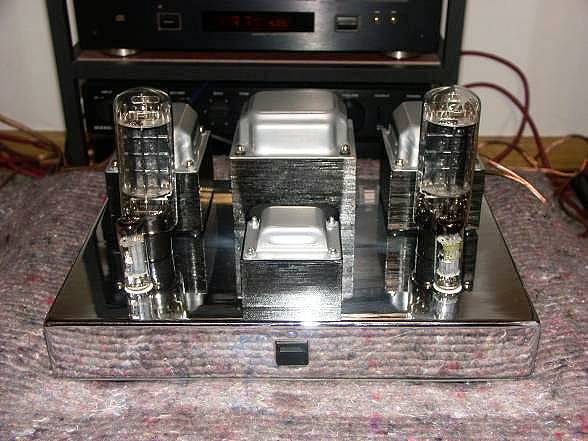

After this contact I continued listening to other songs and all the impressions were very good. The Audiophon 300B showed all its potential when combined properly. It has a warm sound, with great mid and highs, what it is suposed from a tube amp. A good example of what small manufacturers can do.
If you're considering buying an amp based on 300B, the Audiophon deserves your attention. I'm sure that the experince will be satisfaying. Finally, thanks again to Mr. Rafael Molina for his help in doing this audition.